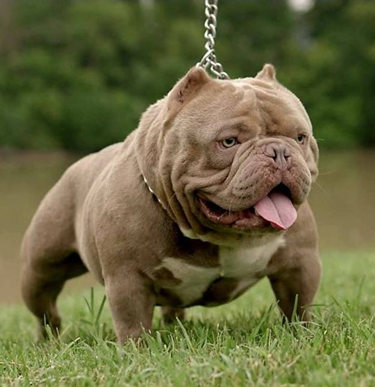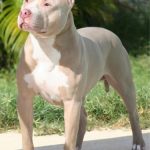
Are you interested in bully breeds? One of the highly sought-after types is the exotic bully. Like their name implies, these bullies are not like the ordinary ones.
While they share many similar traits with a typical bully, they still boast that designer look that you will not see with the others. If you would like to know more about them, let this post serve as your ultimate guide to the exotic bullies.
Origin of Exotic Bully
Exotic bullies were first developed in the early 2000s. The goal of developing them was to have a dog that will be a derivative of American bullies which are new breeds themselves since they were only developed sometime in the 80s.
However, the exotics evolved as a separate breed over time and became an established breed since 2008. Compared to an American bully, these dogs have a wider chest and bigger head but shorter muzzle. But just like their cousins, they are a result of selective breeding.
Recognition
These exotic bully dogs are well-accepted by the canine community despite the controversies that surround them. Because of the extreme features of these dogs, some critics believed the breeders exaggerated in developing them. In spite of this, they are still eligible for registration in organizations like the International Bully Coalition, The American Bully Registry, and the Original Bully Kennel Club.
Because of their uniqueness, many exotics have captured the hearts of dog lovers. Mr. Miagi of the Bully Camp Line is touted as the most famous bully in the world. He’s the offspring of an American Staffordshire Terrier named Marcelo and an American bully named La Madrina.
Appearance of Exotic Bully
As their name suggests, exotic bullies have a few special features that set them apart from the rest. They are compact, have a thick rib cage, and a body length that is virtually the same as their height. They are smaller than American bullies, since they were a result of various small bullies combined but they boast strong muscles and necks, like their American Bully cousins.
When fully grown, an exotic bully stands 9-13 inches tall and weighs 30-50 lbs on average. The female ones are slightly smaller in terms of height but noticeably less bulky than their male counterparts. Majority of female dogs only grow up to 45 lbs as adults. They are often mistaken for pocket bullies, but the latter are actually a bit taller than them.
If you will look at photos of these dogs, you will notice that some are wrinkly from head to toe, although most breeders prefer the “clean” ones or those with the least amount of wrinkles as much as possible. Kennel clubs are still working on the consistency of the breed, since it is a relatively new one. So far, there are only a few faults associated with it.
The coat texture of exotic bully is normally short and smooth. If you brush their coat in a single direction and you touch it, you will notice that it feels a bit firm. Dogs with wavy and sparse coat are least preferred because these are considered faults as per the breed standard. Also, those with a long coat as well as no coat at all do not meet the requirements for the breed.
Like many bully breeds, these dogs may come in a range of colors like chocolate, fawn, black, champagne, and sable. It is also common to see dogs in pie bald pattern or having patches or pigmented spots on areas of the body. Merle, which is a rare pattern in bullies, is an accepted color in exotic bullies.
One of the notable features of exotic bullies is the pigmentation around their eyelids which is actually a requirement for the breed. The color of their eyes can be any color with the exception of albino or pinkish eyes. Also, dogs with different colored eye do not qualify to the breed standard.
You will find these dogs with different types of tail. It’s worth noting that some of them are considered a fault. For instance, short and kinked tails are seen as an unattractive feature. There are also types of tails that are considered a serious fault, such as the bobbed and screw tail.
Personality of Exotic Bully
This breed is often seen as a fierce and intimidating because of its pronounced cheeks and muscular built. However, when raised and trained accordingly, these bullies can be among the friendliest dogs you can ever find. Like an American bully, it is not supposed to be aggressive or too shy since these are considered undesirable characteristics.
Despite their naturally good temperament, exotic bullies are not recommended for novice owners. Although they are fairly easy to groom, they may appear strong and intimidating so it matters that the owner is very good at controlling their pets. Owners of bullies need to be confident in handling dogs.
These exotic bully dogs cannot bear being alone for a long period, hence it’s important to have someone look after them when you are not at home all the time. Their compact size and less active nature makes it easier for them to adapt well to apartment living.
Grooming of Exotic Bully
It’s easy to maintain the coat of an exotic bully because it only involves brushing once a week. For their type of coat, it will be suitable to use a soft brush because their skin can be easily scratched with stiff brushes. Bathing should only be done on occasion because regular baths will remove the natural oil in their skin.
Due to their short coat, exotics may find it challenging to tolerate cold weather. Therefore, it helps to provide them extra protection like dog jackets and coats especially if you live in a country where winter is long and snow falls in excessive amounts.
Like most bully breeds, exotics are prone to shedding, regardless of the fact that they have short coats. Shedding can be easily managed by brushing your dog’s coat using a soft boar-bristled brush or a bristle brush especially created for short-haired breeds.
Parents of bullies may not notice it, but their short strands can accumulate on the floor and furniture after a while. Although they shed, this is only minimal and can be easily managed with regular vacuuming. Bullies that shed excessively should be evaluated by a vet because they may be suffering from a specific health issue.
Health of Exotic Bully
The average lifespan of exotic bully is around 10 years on average. This is on par with the typical lifespan of most bully breeds, although some cannot make it longer than 8 years because of their susceptibility to breathing problems. Apart from difficulties in breathing, here are a few more health issues associated with exotic bullies:
Skin problems – because of their short coats, these dogs do not have much protection from environmental factors. The most common skin problem seen in these dogs is Demodectic mange. It is important to strengthen their immune systems to keep them protected from parasites which are responsible for causing excessive hair loss and scabs.
Elbow and hip dysplasia – bully breeds have a high incidence of hip and elbow dysplasia because of the nature of their bodies. Dogs with hip dysplasia should only have light exercise sessions because strenuous activities can worsen their condition.
Patellar Luxation – when a exotic bully dog’s patella or kneecap is luxating, it means it is suffering from dislocation. This kind of problem in dogs normally requires surgery to be corrected. The goal of undergoing surgery is to restore the normal alignment of the muscles.
Congenital heart failure – dogs with such condition suffer from enlargement of the heart. The body also becomes filled with fluids and causes problems to the dog’s internal organs. Diuretics are usually prescribed to remove the fluid from the body. Some dogs also undergo oxygen therapy and heart monitoring.
How To Feeding Exotic Bully
Exotic bully thrive on a protein-rich diet that comes with good amounts of healthy fats. Meat is a top choice but make sure it is of high-quality. If you prefer serving homemade food, it is best to combine it with some fruits and vegetables. It is important to include variety in your pet’s diet. You may also mix human food with commercially prepared dog food.
Dogs prone to obesity may be given wet dog food which is lower in calories compared to dry dog food. Aside from boosting the dog’s hydration needs, wet food is healthier for the teeth. If your pooch is not used to eating wet food exclusively, you may combine it with dry food.
Exotic bullies will surely appreciate big meaty stews, but be careful not to over-feed them since they can easily become fat. Raw dog food also provides a number of health benefits to bullies. If you want to try raw feeding, ask your vet for recommendations especially if the bully has a sensitive stomach. These dogs are prone to obesity so it is best to keep an eye on what you are feeding them.
Exercise of Exotic Bully
These dogs are playful and tenacious but they are not as active as other bully breeds like the American bullies. They still need daily exercise to keep their joints healthy and to avoid risks of obesity. A 30-minute walk per day is enough to provide the amount of exercise bully breeds need. In addition to walking, you can try other types of physical activities such as swimming and playing games of fetch.
Price of Exotic Bully
Buying one Exotic bully puppy is like buying two American bullies because they are quite on the higher end. In the United States, the starting price for one pup of this breed is $5,000. Exotic designer bullies can even go from $7,500- $15,000. Adult dogs can be priced much higher, with some even costing up to $20,000 each.
Conclusion
The exotic bullies are extreme in many ways. They are the dog of choice for people looking for bullies with many unique characteristics. Despite of some criticisms about them, many pet enthusiasts still prefer them because of their out of the ordinary appearance.





















